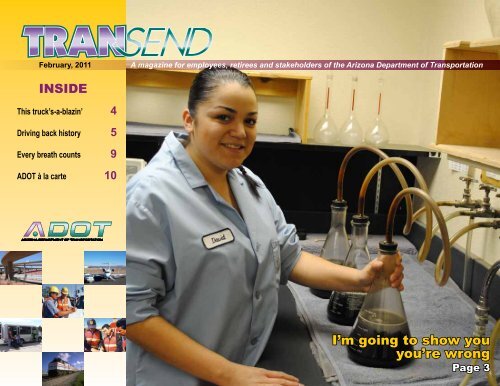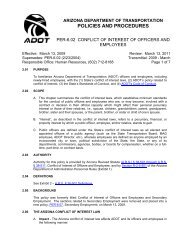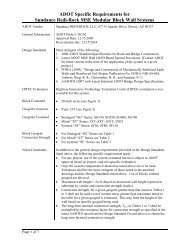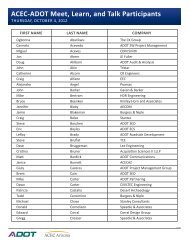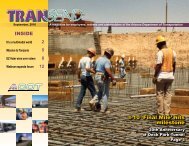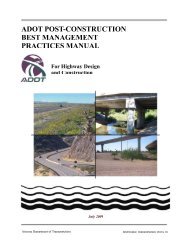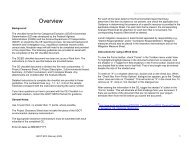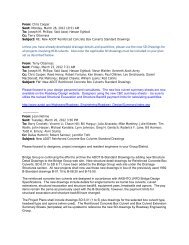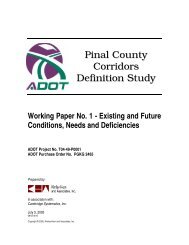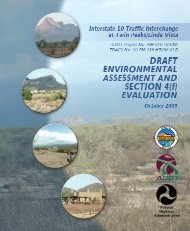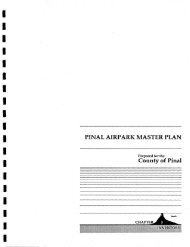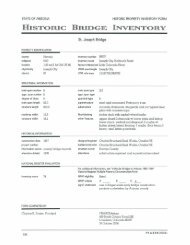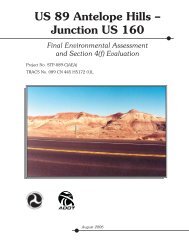TRANsend 2011 - Arizona Department of Transportation
TRANsend 2011 - Arizona Department of Transportation
TRANsend 2011 - Arizona Department of Transportation
You also want an ePaper? Increase the reach of your titles
YUMPU automatically turns print PDFs into web optimized ePapers that Google loves.
February, <strong>2011</strong> A magazine for employees, retirees and stakeholders <strong>of</strong> the <strong>Arizona</strong> <strong>Department</strong> <strong>of</strong> <strong>Transportation</strong><br />
inside<br />
This truck’s-a-blazin’ 4<br />
Driving back history 5<br />
Every breath counts 9<br />
ADOT à la carte 10<br />
i’m going to show you<br />
you’re wrong<br />
Page 3
A Message from<br />
ADOT Leadership<br />
Rob Waddell, human Resources manager<br />
It’s February: time for Valentine’s Day,<br />
President’s Day, and ADOT’s annual employee<br />
performance evaluations. If the last event doesn’t<br />
excite you as much as the first two, you are not<br />
alone.<br />
Most ADOT employees view the performance<br />
evaluations with at least some anxiety because<br />
giving and receiving honest, constructive<br />
feedback can be difficult and unpleasant.<br />
However, if approached as a candid exchange,<br />
the performance evaluation process can benefit<br />
employees and the agency as a whole. An<br />
evaluator has the opportunity to clearly lay out<br />
job expectations at the beginning <strong>of</strong> the rating<br />
period and to identify an employee’s strengths<br />
and weaknesses, or areas needing improvement<br />
throughout the rating period. An employee learns<br />
how he or she is performing in relation to job<br />
expectations and receives specific examples<br />
<strong>of</strong> good or bad performance. Each has an<br />
opportunity to ask job-performance questions to<br />
ensure mutual understanding.<br />
It’s important to realize that the evaluation<br />
process reaches its full potential to benefit<br />
employees when it is utilized throughout the year.<br />
The process begins with the creation <strong>of</strong> a planner,<br />
which entails description <strong>of</strong> an employee’s job<br />
functions and lists expectations for the upcoming<br />
<strong>Arizona</strong> <strong>Department</strong> <strong>of</strong> <strong>Transportation</strong> February, <strong>2011</strong><br />
year. After the planner is finalized, it’s critical<br />
that the supervisor and the employee(s) meet to<br />
discuss the expectations to ensure the employee<br />
fully understands the expectations <strong>of</strong> the job. The<br />
clearer the expectations, the higher the likelihood<br />
the employee will succeed in the position.<br />
For evaluation purposes, a planner runs from<br />
February through the following January, after<br />
which an evaluation is conducted. So, evaluations<br />
being conducted this month are based on planners<br />
established last year.<br />
Ideally, a supervisor should meet with the<br />
employee at least quarterly to keep lines<br />
<strong>of</strong> communication open, recognize any<br />
accomplishments or areas exceeding expectations,<br />
and address areas <strong>of</strong> concern. These items should<br />
be documented in the planner and followed-up<br />
with a discussion. Regular feedback prevents<br />
surprises. Exemplary performance can also be<br />
recognized with awards and recognition tools.<br />
Responses to several <strong>of</strong> the questions in the<br />
2009 ADOT employee survey shed light on the<br />
performance evaluation process.<br />
When asked if “I understand what is expected<br />
<strong>of</strong> me at work,” 94 percent agreed or strongly<br />
agreed. A similar response (95%) was recorded<br />
for “I understand how my job contributes to<br />
ADOT.”<br />
Continued on page 13<br />
TRANSEND is published monthly for the employees and<br />
retirees <strong>of</strong> the <strong>Arizona</strong> <strong>Department</strong> <strong>of</strong> <strong>Transportation</strong> by<br />
the Creative Services Group <strong>of</strong> the Communication and<br />
Community Partnerships Division.<br />
The TeAm<br />
ADOT Director John S. Halikowski<br />
editor John Tucker<br />
Associate editor Bob Albano<br />
Production Artist Matt Feyereisen<br />
editorial Board<br />
Lisa Andersen, Intermodal <strong>Transportation</strong> Division<br />
Larry Clark, Motor Vehicle Division<br />
Cydney Demodica, Motor Vehicle Division<br />
Dan Dudzik, Communication & Community Partnerships<br />
Bret Anderson, Multimodal Planning Division<br />
Sarah Wuertz, <strong>Transportation</strong> Services Group<br />
Address all comments and suggestions to:<br />
TRANSEND Editors<br />
1130 N. 22nd Ave.<br />
Phoenix, AZ 85009 MD 069R<br />
or email jtucker@azdot.gov<br />
Page 2<br />
NeXT ISSUe DeADLINe FeB 27 th<br />
Submit articles, stories and photographs to:<br />
jtucker@azdot.gov or<br />
balbano@azdot.gov<br />
All submissions for publication are subject to editing for<br />
spelling, grammar, and technical accuracy; and may be<br />
rewritten for clarity, continuity, length, and journalistic style.<br />
Past issues <strong>of</strong> TRANSEND can be found by going to<br />
azdot.gov/CCPartnerships/<strong>TRANsend</strong>/Back_Issues.asp<br />
Cover Photo: Safety Calendar winners include, from left,<br />
Alice Wong, Rohit Saju, Dineh Ben, Mikaela Reynolds,<br />
Tiara Jones, Toahani Chief, Teya Sanchez, Macy Moore,<br />
Isabella Cantua, Savio Pinto, and Joshua I. Hernandez.<br />
Winners not pictured are Canyon Cooke, Jillian Crandall,<br />
and Hannah Marie Adame. Pictured in back, Sonya Herrera,<br />
the Highway Hawk, and Director Halikowski.
Proving her ‘doubters’ wrong<br />
Tucson District intern on road to realizing childhood engineering dream<br />
By C.T. Revere, PIO Safford District<br />
Monica Soto built her first roads when she was<br />
still a child.<br />
“When I was a little girl, my dad had some old<br />
Tonka trucks, and I’d take them in the back yard and<br />
build roads for them,” Soto said. “I’ve always loved<br />
roads and bridges.”<br />
Now 23, Soto is building on her childhood<br />
fascination, studying civil engineering at the<br />
University <strong>of</strong> <strong>Arizona</strong> and spending several days a<br />
week as an intern in the <strong>Arizona</strong> <strong>Department</strong><br />
<strong>of</strong> <strong>Transportation</strong>’s Tucson District Office.<br />
After earning her degree, Soto has her<br />
sights set on entering ADOT’s Engineer in<br />
Training Program and exploring the many<br />
opportunities transportation <strong>of</strong>fers for civil<br />
engineering.<br />
“I’m interested in going into construction,”<br />
she said.<br />
It’s a career path the Tucson native might<br />
never have taken if she’d heeded the advice<br />
<strong>of</strong>fered by many.<br />
“I don’t know how many times I’ve been<br />
told that women don’t belong in engineering<br />
– women don’t belong in construction,” Soto<br />
said one day recently while taking a break<br />
from testing asphalt mixtures at the Tucson<br />
Regional Lab.<br />
With encouragement from her parents, Soto<br />
began pursuing her dream as a seventhgrader<br />
at Utterback Middle School in<br />
<strong>Arizona</strong> <strong>Department</strong> <strong>of</strong> <strong>Transportation</strong> February, <strong>2011</strong><br />
Tucson. She enrolled in a NASA-based summer<br />
program at Pima Community College for students<br />
who show aptitude in math and science. Each year,<br />
she passed a test required to remain in the program,<br />
the first signs that she was indeed going to prove her<br />
doubters wrong.<br />
“We had a class in the third summer that required<br />
you to research the fields <strong>of</strong> engineering that<br />
interested you,” Soto recalled. “When I was doing<br />
my research, I made the connection that I wanted to<br />
be a civil engineer. It became my goal at the age <strong>of</strong><br />
14.”<br />
Page 3<br />
Still, she encountered naysayers, including one<br />
school counselor who discouraged her from<br />
enrolling in courses integral to learning her trade.<br />
Undaunted, Soto learned computer-assisted drafting<br />
as a freshman at Tucson High School. In her<br />
sophomore year, she attended the UA’s Summer<br />
Engineering Academy, and before graduating she<br />
landed a summer job with ADOT that was intended<br />
to introduce her to highway maintenance operations.<br />
“I was the only girl in about 20 students and, after<br />
they had called everybody else’s name, I was asked<br />
if I wanted to work at the front desk,” she said. “At<br />
first, I thought it was because I was a girl. But then<br />
I realized this was a good thing because at the front<br />
desk I met everybody.” Ø<br />
Lab work is a part <strong>of</strong> Monica Soto’s training.
One <strong>of</strong> the ADOT employees she met encouraged<br />
Soto to apply for an internship with Jerry James,<br />
then the Tucson District resident engineer.<br />
“I did that and I really, really liked it. He wanted<br />
me to get full exposure to the kind <strong>of</strong> work he did. I<br />
basically shadowed Jerry James,” she said.<br />
That experience helped Soto land an ADOT<br />
internship she has held ever since she started college,<br />
an opportunity that has given her a significant edge<br />
in the classroom.<br />
“Working here in the materials lab has helped me<br />
to understand so much,” she said. “It’s so much<br />
easier to learn in the real world than by reading it in<br />
books.”<br />
Soto’s aptitude, drive, and dedication have earned<br />
her several scholarships to help cover the cost <strong>of</strong><br />
earning a double degree in civil engineering and<br />
creative writing.<br />
Most recently, she was selected for the Women<br />
<strong>Transportation</strong> Seminar Tucson Chapter’s Katie<br />
Dusenberry Scholarship for 2010.<br />
“Monica exhibited the skill sets and tenacity that we<br />
want to see in women who go into the transportation<br />
field,” said Natalie Clark, past president <strong>of</strong> WTS<br />
in Tucson and an ADOT project manager for<br />
enhancements and scenic roads. “She is an achiever<br />
and a go-getter and that’s important because as<br />
women we do hear that we don’t belong in this<br />
field.”<br />
While the $1,000 scholarship will help Soto cover<br />
the cost <strong>of</strong> books and classroom supplies, its greater<br />
value is the validation it provides.<br />
“How many more women are discouraged because<br />
<strong>of</strong> what they hear?” she said. “That’s my motivation.<br />
I’m going to show you you’re wrong.”<br />
<strong>Arizona</strong> <strong>Department</strong> <strong>of</strong> <strong>Transportation</strong> February, <strong>2011</strong><br />
Man’s truck saved with help <strong>of</strong> ADOT employees<br />
instead <strong>of</strong> having to watch flames destroy his<br />
truck, William Harvey got to see two ADOT<br />
employees quickly jump into action.<br />
According to a letter <strong>of</strong> appreciation he wrote to<br />
ADOT <strong>of</strong>ficials, Harvey was driving on Jan. 6 from<br />
Phoenix to Kingman and was about four miles east<br />
<strong>of</strong> the Burro Creek Bridge on State Route<br />
93 when he started to smell something<br />
burning. He pulled <strong>of</strong>f the highway once<br />
his truck’s cab started to fill with heavy<br />
grey smoke. Knowing he had just removed<br />
his fire extinguisher the weekend before,<br />
Harvey says in his letter that he began<br />
removing his personal belongings and<br />
assumed the worst.<br />
But very soon help arrived in the form <strong>of</strong> an<br />
ADOT truck driving in his direction.<br />
“Within two minutes the ADOT truck I had<br />
passed earlier came over a rise and pulled<br />
ahead <strong>of</strong> my truck,” Harvey writes. “The two<br />
ADOT employees grabbed extinguishers <strong>of</strong>f<br />
<strong>of</strong> their truck and proceeded to put out the<br />
fire. I have little doubt that if it had not been<br />
for the quick actions <strong>of</strong> Mr. Eloy Armendariz<br />
and Mr. Lalo Siqueiros, my truck likely<br />
would have been destroyed.”<br />
Ransom Spurlock, the operations<br />
superintendent in the Kingman district, says it<br />
was good to receive Mr. Harvey’s letter.<br />
“It’s nice to see the guys get recognized for what<br />
they do every day,” Spurlock said, adding that<br />
Armendariz and Siqueiros, who each serve as a tech<br />
III, are great employees.<br />
“These are two <strong>of</strong> my best hardest working guys,”<br />
he said <strong>of</strong> the pair who work out <strong>of</strong> the Wikieup<br />
maintenance yard.<br />
Highway Operations Supervisor Randy Morris<br />
agrees.<br />
Page 4<br />
“They’re good people,” he said <strong>of</strong> Armendariz and<br />
Siqueiros. “They’ll help anyone at anytime.”<br />
Armendariz says it was just part <strong>of</strong> his job to lend a<br />
helping hand.<br />
“It’s always different,” he said <strong>of</strong> what he comes<br />
across each day. “Sometimes we just help someone<br />
out with a flat tire. … We just try to help.”<br />
Continued on page 12
Apache Trail:<br />
ADOT helps a project to repair a roadway and preserve <strong>Arizona</strong> history<br />
By Bob Albano<br />
History lurks behind every rock,<br />
and scenery flashes out at every<br />
curve along State Route 88, better<br />
known as the Apache Trail linking<br />
metro Phoenix and the Salt River<br />
reservoirs.<br />
Stretching 47 miles between<br />
Apache Junction and Theodore<br />
Roosevelt Dam, the road rolls,<br />
climbs, and dips over and around<br />
rugged terrain with hairpin curves<br />
and the barest <strong>of</strong> widths for<br />
passages. Those traits challenged<br />
the road’s builders in the first<br />
decade <strong>of</strong> the 20th century and the<br />
crews now completing repairs on it.<br />
Heavy rains necessitated the<br />
repairs. Torrents <strong>of</strong> run<strong>of</strong>f water<br />
during the winter <strong>of</strong> 2009-2010<br />
damaged several retaining walls and other parts <strong>of</strong><br />
the roadway over a 4-mile-long unpaved section<br />
between the Fish Creek Hill rest area and an <strong>Arizona</strong><br />
<strong>Department</strong> <strong>of</strong> <strong>Transportation</strong> maintenance yard<br />
located about 1 mile west <strong>of</strong> the Apache Lake<br />
Marina exit. Repair work began last November;<br />
completion is expected by the end <strong>of</strong> February.<br />
Since the 1980s, the Apache Trail has been among<br />
the designated roads in the scenic and historic byway<br />
programs <strong>of</strong> ADOT and the U.S. National Forrest.<br />
For detailed information, visit these Web sites:<br />
http://www.byways.org/explore/byways/2058<br />
<strong>Arizona</strong> <strong>Department</strong> <strong>of</strong> <strong>Transportation</strong> February, <strong>2011</strong><br />
Water pours over Apache Trail at Tortilla Flat in late 2009,<br />
before the repair project began. Photo by Larry Copeland<br />
<strong>of</strong> Roosevelt Maintenance. More photos on pages 6-7.<br />
http://www.arizonascenicroads.com<br />
Because <strong>of</strong> the federal status, the repair project<br />
qualified for the Emergency Relief for Federally<br />
Owned Roads program. According to the Federal<br />
Highway Administration, the program “is to pay the<br />
unusually heavy expenses to agencies, that manage<br />
road systems, for the repair and reconstruction <strong>of</strong><br />
Federal roads to pre-disaster conditions. These<br />
Federal roads were damaged by a natural disaster<br />
over a wide area or by a catastrophic failure from<br />
any external cause.”<br />
Dan Onisko, is project manager for FHWA, which Ø<br />
Are you new to<br />
State Government?<br />
Think Retirement is too far <strong>of</strong>f and will worry<br />
about it later?<br />
Ever wondered what the terms ASRS or<br />
Deferred Compensation means?<br />
Need explanation <strong>of</strong> what exactly is a 457<br />
(b) supplemental retirement plan, or 401(a)<br />
plan?<br />
Unsure about what Retirement programs or<br />
benefits you may have with the State <strong>of</strong> AZ?<br />
Confused by the RASL program?<br />
If you answered “yes“ to any <strong>of</strong> the above,<br />
please consider attending the KNOW YOUR<br />
BENEFITS presentation that will be <strong>of</strong>fered to<br />
ADOT employees. Representatives from <strong>Arizona</strong><br />
State Retirement System, Nationwide, and DOA<br />
RASL program will be on site.<br />
There will be 2 sessions on<br />
Page 5<br />
Wednesday, February 23, <strong>2011</strong>.<br />
10:00am-11:30am and 1:00pm-2:30pm<br />
All sessions held in the ADOT auditorium located at<br />
206 S 17th Ave<br />
Seating is limited, so please RSVP to John Bennett<br />
at Bennej11@nationwide.com<br />
or call 602-266-2733 x1178<br />
Please note: If you are unable to attend on this<br />
date, we can bring a presentation to you and work<br />
group at your location. Please let John know <strong>of</strong> your<br />
interest at Bennej11@nationwide.com<br />
This is your opportunity to learn about benefits the<br />
State <strong>of</strong> <strong>Arizona</strong> <strong>of</strong>fers to employees regarding<br />
retirement!
has the lead role in the repair project. ADOT<br />
participated in planning sessions and handles public<br />
information and outreach.<br />
Originally, the route was nothing but a narrow,<br />
rugged trail. It was converted to transport heavy<br />
equipment and supplies a distance <strong>of</strong> nearly 60 miles<br />
from the town <strong>of</strong> Mesa to the Theodore Roosevelt<br />
Dam site.<br />
According<br />
to one<br />
historical<br />
account,<br />
“Some <strong>of</strong><br />
the most<br />
difficult and<br />
dangerous<br />
work had to<br />
be done by<br />
hand. Almost<br />
400 “force<br />
account”<br />
laborers<br />
were housed<br />
in six camps<br />
along the route and worked through the spring and<br />
summer. The Apache Indians provided much <strong>of</strong><br />
this labor force, working long hours under brutal<br />
summertime conditions – conditions that required<br />
treks <strong>of</strong> up to four miles for drinking water.”<br />
The Salt River Project notes that the road was<br />
completed in 1905 and called the Mesa-Roosevelt<br />
Road. Construction cost: $250,000.<br />
Today the Apache Trail is a highway that connects<br />
three <strong>of</strong> SRP’s dams on the Salt River: Theodore<br />
Roosevelt Dam, Mormon Flat Dam and Horse Mesa<br />
Dam. In 1987, this 62-mile area was dedicated as<br />
<strong>Arizona</strong>’s first historic highway.<br />
<strong>Arizona</strong> <strong>Department</strong> <strong>of</strong> <strong>Transportation</strong> February, <strong>2011</strong><br />
Historic markers along the road recognize Al Sieber<br />
(sometimes spelled Seiber) and Alchesay. Sieber<br />
was the Army’s chief <strong>of</strong> scouts during the Apache<br />
wars, and Alchesay was a White Mountain Apache<br />
chieftain who served as a scout and received the<br />
Medal <strong>of</strong> Honor. Sieber was leading a construction<br />
crew including Apaches when he was killed in an<br />
accident. The Alchesay marker is near milepost 241,<br />
at the canyon named after him. The Sieber marker is<br />
near milepost 245.<br />
In planning the current repairs, engineers drew from<br />
a document titled “State Route 88 (The Apache<br />
Trail): Historic Content Analysis for Planning Safety<br />
Enhancements to the Trail.” The report was prepared<br />
for ADOT’s Roadside Development Section.<br />
Included in the report is this account:<br />
“The trail up Fish Creek Hill, which later became<br />
the most picturesque <strong>of</strong> the road, was first made<br />
possible for horses by Al Sieber, U.S. Scout, and a<br />
Troop <strong>of</strong> the 4th Cavalry in 1873, when following a<br />
band <strong>of</strong> hostile Indians from upper Salt River. The Ø<br />
Worksite 4<br />
Page 6
Indians crossed to the north side <strong>of</strong> Salt River on<br />
the riffle at the mouth <strong>of</strong> the sand wash where the<br />
Roosevelt Road strikes the river, seven miles below<br />
Roosevelt.<br />
“The river being too high for the troops to cross with<br />
their pack train, they continued down the south side<br />
<strong>of</strong> the river, spending three days’ labor on Fish Creek<br />
Hill before they succeeded in getting their animals<br />
out <strong>of</strong> the canyon. All the mucking and shovel work<br />
on the road was done by Apache Indians working<br />
under their chiefs. Later these Indians developed into<br />
valuable laborers and were used in the maintenance<br />
work on the road during the building <strong>of</strong> the<br />
Roosevelt Dam.”<br />
<strong>Arizona</strong> <strong>Department</strong> <strong>of</strong> <strong>Transportation</strong> February, <strong>2011</strong><br />
Page 7<br />
APACHE TRAIL PHOTOS — Preceding page, left: Map shows a portion<br />
<strong>of</strong> State Route 88, the Apache Trail. Preceding page, top: The Army’s<br />
chief <strong>of</strong> scouts, Al Sieber, is memorialized in this monument. Preceding<br />
page, bottom: Bridge abutments were repaired and reinforced. This<br />
page, top: Damage near milepost 226. This page, left: Reinforcing a<br />
wall between Canyon and Apache lakes. This page, above: Reinforing<br />
alongside the roadway. Worksite photos by Larry Copeland <strong>of</strong> Roosevelt<br />
Maintenance; monument photo by Bill Kirchner, Tucson, contributing<br />
correspondent <strong>of</strong> the Historical Marker Database.
Now hear this:<br />
Protecting your ears is easier than ever thanks to online version <strong>of</strong> ADOT’s annual hearing conservation class<br />
More than 2,000 ADOT employees who are exposed<br />
to hazardous noise in their jobs must take the class<br />
annually to comply with hearing conservation<br />
standards set by the federal Occupational Safety and<br />
Health Administration. The standards are included in<br />
ADOT’s Hearing Conservation Policy, SAF 13.01.<br />
Created by the Safety and Health section and the<br />
ITG Web Team, the online class recorded its pilot<br />
presentation in December and went live in January<br />
on the ADOT Learning Center.<br />
http://adotlms/stc/adot/psciis.<br />
dll?MAINMENU=ADOT<br />
“The class is on-demand, so you can take it at your<br />
convenience and go at your own pace,” Safety and<br />
Health Manager Sonya Herrera says. “It’s a cost<br />
savings too, because employees don’t have to travel<br />
to take the class.”<br />
Previously, employees attended classes in person,<br />
some traveling long distances to do so. A few years<br />
ago, ADOT hired a vendor to provide the class<br />
online to reduce travel costs and make it more<br />
convenient. The service was canceled last year<br />
because <strong>of</strong> budget cuts.<br />
Classroom training was reintroduced for a few<br />
months, giving the Safety and Health Team<br />
employees and Web Team member Cyndi Striegler<br />
time to create the new training module in-house.<br />
Striegler used existing course material and converted<br />
it to the online format. It was tweaked a few times<br />
during the process to improve the content and<br />
presentation.<br />
The course covers the effects <strong>of</strong> noise on hearing, “It<br />
<strong>Arizona</strong> <strong>Department</strong> <strong>of</strong> <strong>Transportation</strong> February, <strong>2011</strong><br />
consists <strong>of</strong> training modules, and a final assessment.<br />
Once you pass the course, it automatically records<br />
that you’ve met your training requirements,”<br />
Striegler says.<br />
Herrera touts other benefits <strong>of</strong> the new class. “It<br />
allows us to tailor the training to the type <strong>of</strong> work<br />
our employees do, and if employees suggest ways<br />
to improve the class, we can easily implement<br />
changes,” she says.<br />
Joe Reed, area manager for Traffic<br />
Signals for the Northern Region,<br />
recently took the new<br />
course and described it as<br />
“excellent and very well<br />
done.”<br />
In addition to the annual<br />
training, employees in<br />
the hearing conservation<br />
program must undergo<br />
an audiogram (hearing<br />
test) each year and<br />
receive the test results.<br />
The ADOT program also<br />
includes noise monitoring,<br />
noise-control methods, and<br />
hearing protection devices for<br />
employees.<br />
According to the National<br />
Institute for Occupational<br />
Safety and Health, noiseinduced<br />
hearing loss is the most<br />
preventable occupational injury.<br />
It’s a message that Herrera wants<br />
employees to hear loud and clear.<br />
Page 8<br />
“The main reason we really focus on the heath<br />
conservation program is that it’s a quality <strong>of</strong> life<br />
issue, because there is no cure for hearing loss,”<br />
Herrera says. “Hearing aids can help, but continued<br />
exposure to loud noise will eventually lead to<br />
complete hearing loss, and that’s why conservation<br />
is so important.”
Running has always been a way <strong>of</strong> life for ADOT’s John Curley, Jr.<br />
The highway operations tech from Ganado<br />
Maintenance grew up in the community <strong>of</strong><br />
Steamboat on the Navajo Reservation in<br />
northeastern <strong>Arizona</strong>. From the age <strong>of</strong> 10, he<br />
remembers being awakened by his father each<br />
day before dawn and sent out to run, regardless<br />
<strong>of</strong> the weather. According to Navajo beliefs,<br />
running in the early morning when stars are the<br />
only light gives the runner physical and mental<br />
strength for the day and for life.<br />
“My father used to say, ‘I’m not going to be there for<br />
you all the time. Someday I will fly away like a bird.<br />
Along the way you will encounter challenges. Now<br />
is the time to get strong,’ ” Curley said.<br />
Curley, 46, took his father’s advice, developing into<br />
an elite long-distance runner who has won or placed<br />
in dozens <strong>of</strong> races and competed in many more,<br />
including the 2007 Boston Marathon (every longdistance<br />
runner’s dream). He finished the grueling<br />
course in 3 hours, 17 minutes, 26 seconds, all in<br />
the rain. His time was a little more than 37 minutes<br />
faster than the average time <strong>of</strong> the more than 20,300<br />
finishers.<br />
Along with physical stamina, he acquired a mental<br />
toughness that has helped him weather many<br />
adversities, such as the death <strong>of</strong> his father in 2006.<br />
Curley decided to run in this year’s P.F. Chang’s<br />
Rock ’n‘ Roll Marathon<br />
(Jan. 16) in Phoenix on<br />
behalf <strong>of</strong> an older sister,<br />
recently diagnosed with<br />
cancer.<br />
“When a family member has a disease, it takes a toll<br />
on you mentally and emotionally,” he said.<br />
<strong>Arizona</strong> <strong>Department</strong> <strong>of</strong> <strong>Transportation</strong> February, <strong>2011</strong><br />
The P.F. Chang’s Marathon took its toll on Curley’s<br />
body.<br />
“I wasn’t prepared for this run. I didn’t train months<br />
beforehand like I normally would,” he explained.<br />
His work schedule, cold weather, and early sunsets<br />
cut into his usual regimen. But he had committed to<br />
run for his sister. “When a person is diagnosed with<br />
an illness, their fight begins right then and there.<br />
There is no training.” He approached the marathon<br />
one step at a time.<br />
One <strong>of</strong> his feet began to blister at mile 12, but<br />
Curley ignored the pain by visualizing himself riding<br />
bareback on his horse. He also focused on how<br />
small his aches were compared<br />
to the pain suffered by seriously<br />
ill patients like his sister. “I told<br />
myself, this pain is nothing with<br />
what others live with daily.”<br />
Curley pressed on and finished<br />
the marathon in an impressive 3<br />
hours, 15 minutes, a time good<br />
enough to qualify him for this<br />
year’s Boston Marathon in his<br />
age division, 45-49. (He won’t<br />
be going to Boston because a<br />
daughter is graduating from high<br />
school around the same time.)<br />
“It was an honor to run on behalf<br />
<strong>of</strong> my sister,” Curley said. “It<br />
was an uplifting feeling to see<br />
her standing at the side <strong>of</strong> the<br />
course, cheering me on. It’s all<br />
about being thankful for the gift<br />
<strong>of</strong> movement and to use it to the<br />
best <strong>of</strong> your ability.”<br />
Page 9<br />
Curley, who has six children ranging from age 6 to<br />
22, frequently speaks to groups on the reservation<br />
about the benefits <strong>of</strong> running and general exercise.<br />
Three years ago, the family launched a 10K run on<br />
Father’s Day called Running for Life. “It’s a way<br />
to encourage community members to make healthy<br />
changes in their daily lives,” Curley says. “It’s<br />
something that everyone — young and old — can<br />
do.” It’s held on Father’s Day in honor <strong>of</strong> Curley’s<br />
father.<br />
Sixty runners participated the first year, 120 ran last<br />
year, and the family hopes for even more runners Ø<br />
“Every breath counts.”<br />
- John Curley, Jr
this year. For a $12 entry fee, participants receive a<br />
T-shirt, goodie bag, and awards for the top finishers.<br />
The motto for the race is: “Dream it, Walk it, Jog it,<br />
Run it, Live it. There’s a way for everyone.”<br />
Shortly before the first run, Curley’s oldest daughter<br />
was involved in a serious car accident. She was in<br />
a coma for several weeks. “When you sit there in<br />
the ICU day after day and watch the life-line on the<br />
heart monitor,<br />
you realize how<br />
precious life<br />
is,” Curley said.<br />
Thankfully,<br />
the daughter<br />
recovered<br />
completely.<br />
The Running<br />
for Life logo<br />
incorporates a<br />
heart monitor<br />
life line in<br />
its design to<br />
celebrate her<br />
life.<br />
Every year,<br />
Running in the P.F. Chang marathon<br />
Curley<br />
celebrates his<br />
Aug. 7 birthday by running the distance <strong>of</strong> his age.<br />
Last year, he ran 46 miles nonstop in 8.5 hours. “I<br />
can’t have my birthday cake until I finish my run,”<br />
he said.<br />
He extends an invitation to anyone who would like<br />
to join him for his 47th birthday run.<br />
“It’s all about just getting out there and moving,” he<br />
said. “Every breath counts.”<br />
<strong>Arizona</strong> <strong>Department</strong> <strong>of</strong> <strong>Transportation</strong> February, <strong>2011</strong><br />
Page 10<br />
Like the Energizer Bunny, ADOT’s cookbook keeps<br />
going and going — selling that is.<br />
Consisting <strong>of</strong> recipes donated by ADOT<br />
employees, the book was published in 2001 to<br />
raise money for the awards and recognition<br />
program, primarily the annual ADOT picnic,<br />
said Sarah Wuertz, the program’s administrator.<br />
Some <strong>of</strong> those who participated in the book<br />
project have left ADOT, but their work endures.<br />
A thorough compilation, the spiral-bound book<br />
(it lays flat on the counter while you’re cooking)<br />
includes 242 pages [8 ½ X 11 inches] <strong>of</strong> recipes<br />
grouped into sections focusing on appetizers,<br />
snacks, and beverages; breads and pastries; desserts,<br />
including candies and cookies; main dishes, pasta,<br />
and sauces; meat, poultry, and fish; salads and soups;<br />
and vegetables, rice, and side dishes.<br />
Just in time for Spring Training, the appetizer section<br />
includes (with cooks listed in brackets) bourbon<br />
dogs [Tammy Homberg], cheese boats [Jimmy<br />
Parks, from his mother, Deanie Justice], Tiny Burger<br />
Appetizers [Judy Barrette]. Or if you need desserts<br />
and drinks for your Oscar party, consider Academy<br />
Awards Night Brownies [anonymous] paired with a<br />
B-52 [Armand Celeya], champagne punch [Tammy<br />
Homberg], or rose petal wine [Laura Boden, from<br />
her Gramma Ruby]. The latter’s ingredients include<br />
a bushel <strong>of</strong> ripe rose petals.<br />
There’s more, including two pages devoted to<br />
Nepalese and Indian food, courtesy <strong>of</strong> Bharat Kandel<br />
<strong>of</strong> the Intermodal <strong>Transportation</strong> Division. In the<br />
book, Kandel says, “Here I am providing the recipe<br />
for cooking lamb or chicken with Nepalese spices. .<br />
. . When I cook, I don’t weigh the spices. However, I<br />
use spoons and my judgment to decide the quantities<br />
I’ll use.”<br />
The book’s credit page gives “special thanks”<br />
to Armand Celeya, who had written a personal<br />
cookbook; Darlene Wilke, who learned to cook from<br />
scratch without a recipe; Dave Monson, for sharing<br />
a wild game recipe; Ellen Damron, who directed<br />
the cookbook team and provided recipes; Laura<br />
Boden, who shared recipes from her Gramma Ruby,<br />
a chef, caterer, and food columnist who published<br />
15 cookbooks; Michael S. Herrington, who won<br />
first place in the 1999 ADOT chili cook-<strong>of</strong>f; and<br />
the cookbook team consisting <strong>of</strong> John Hauskins,<br />
Judy Barrette, Leroy Brady, Nettie Klingler, Sabra<br />
Mousavi, Sarah Wuertz, Tammy Homberg, and Tim<br />
Ahrens.<br />
The book can be ordered for $5 from this site:<br />
http://adotnet/Programs/Awards_Recognition/<br />
FundRaising/Sales/Cookbook.asp
Comments & Kudos<br />
Happy riding<br />
As a bike rider from the foothills in Yuma (the same<br />
group as Mark), I want to thank you for sweeping<br />
the pass. I rode the pass yesterday and did find it in<br />
excellent condition. Thank you again.<br />
Lisa H.<br />
Thank you Ms. Gonzales, and your crew for cleaning<br />
the shoulder for the cyclists… one <strong>of</strong> the riders.<br />
Jacob Dekok<br />
Please pass this big “THANK YOU” on to the<br />
operator <strong>of</strong> the sweeper that cleaned the shoulder <strong>of</strong><br />
HWY 260 between Camp Verde and Cottonwood on<br />
Jan. 24. 11. He certainly did a “GREAT” job and I<br />
really appreciate it!!<br />
Ilse Pettey, The daily bicycle rider<br />
Caring service<br />
A Tucson customer <strong>of</strong> MVD took a moment to call<br />
in her thanks for caring service. Here’s what Laura<br />
Brock <strong>of</strong> the MVD Customer Servide Program<br />
reported:<br />
We received a call from Kim Hickie, who was just<br />
in the Tucson North <strong>of</strong>fice this morning to take care<br />
<strong>of</strong> some business issues due to her Aunt passing<br />
away. Kim wanted Customer Service Management<br />
to know how difficult the transaction was and she<br />
appreciated all the kind, supportive assistance<br />
she received from Supervisor Irma Thurlow and<br />
CSR Jackie Eugene. Kim said so many times, the<br />
employees don’t care what your issues are, they just<br />
want you in and out with little or no interaction.<br />
Kim said it is very heartfelt that these employees<br />
<strong>Arizona</strong> <strong>Department</strong> <strong>of</strong> <strong>Transportation</strong> February, <strong>2011</strong><br />
took the time to care and wanted to call in and<br />
acknowledge the excellent service received.<br />
Honoring military members.<br />
Newspapers around <strong>Arizona</strong> heralded ADOT’s<br />
commitment to public service by recognizing the<br />
efforts <strong>of</strong> active duty and veteran members <strong>of</strong> the<br />
United States military. Here is an excerpt from one<br />
<strong>of</strong> the articles about ADOT’s role:<br />
ADOT, in partnership with various governmental<br />
agencies and nonpr<strong>of</strong>it organizations, has erected<br />
monuments throughout the state to recognize the<br />
contributions <strong>of</strong> veterans, both past and present.<br />
Many <strong>of</strong> the monuments date back to the 1800s.<br />
One example is the dedication <strong>of</strong> the Blue Star<br />
Memorial Highway, which is designated on several<br />
segments <strong>of</strong> <strong>Arizona</strong>’s public highways. The<br />
segments are located in Yuma County along Business<br />
Route 8, Business Route 19 in Santa Cruz and<br />
Pima counties, and near milepost 612 on US 89A in<br />
Coconino County.<br />
More recently, ADOT transferred ownership <strong>of</strong> the<br />
Veterans Bronze Memorial Plaque to the City <strong>of</strong><br />
Prescott. ADOT also provided and installed a second<br />
plaque that honors all <strong>of</strong> the United States Armed<br />
Services.<br />
The flags at the McGuireville Veterans Memorial<br />
were raised once again in October 2010 with the<br />
reopening <strong>of</strong> the rest area. The McGuireville rest<br />
area is located along Interstate 17, just north <strong>of</strong><br />
Camp Verde.<br />
Page 11<br />
In addition to the statewide monuments, ADOT<br />
has numerous specialty license plates which allow<br />
vehicle owners to pay their respects to those who<br />
served our country proudly. This honor is shown<br />
through recognition <strong>of</strong> an individual or a family<br />
member’s contribution, awards received or other<br />
distinguished service.<br />
The specialty license plate program allows ADOT<br />
to partner with various organizations that provide<br />
financial support or other services to veterans, with<br />
some <strong>of</strong> the plate fees returning to the sponsoring<br />
organization to aid in these efforts.<br />
No further questions<br />
MVD’s Clementine Webb responded to a customer’s<br />
question:<br />
Good afternoon. Thank you for your inquiry. To view<br />
prior vehicle registration fees paid, go to<br />
www.servicearizona.com, under “All Services” click<br />
on “Vehicle Fee Recap” and follow the prompts.<br />
Thank you for using our email service. Have a nice<br />
day.<br />
The customer replied:<br />
No further questions, however I wish to thank<br />
you for your EXCELLENT service! You guys are<br />
AWESOME! Your website is just as incredible. Keep<br />
up the great job! I love MVD! How <strong>of</strong>ten do you<br />
hear somebody say that? :)
Fire story continued from page 4<br />
Siqueiros is equally modest, noting that the<br />
majority <strong>of</strong> motorists they assist have cars that have<br />
overheated or flat tires.<br />
“We just took a chance and tried to do our best,”<br />
he said <strong>of</strong> the truck fire. “It’s nice when people<br />
recognize.”<br />
Harvey writes in his letter that he is a former<br />
ADOT employee and appreciates the value <strong>of</strong><br />
being recognized for service provided. “ADOT’s<br />
Executive Leadership statement says that employees<br />
are the cornerstone <strong>of</strong> ADOT’s success. Eloy and<br />
Lalo certainly are examples <strong>of</strong> that philosophy and I<br />
want to add my support to that view.”<br />
Transit Fare<br />
Ann Cochran, CTPA, a Transit Programs specialist<br />
with the Multimodal Planning Division, lists transit<br />
events:<br />
● Lake Havasu City held an open house Feb. 9 to<br />
mark the opening <strong>of</strong> a transit administration facility,<br />
funded through formula and ARRA transit grants.<br />
● The city <strong>of</strong> Coolidge is holding a ribbon cutting<br />
ceremony Feb. 22 to commemorate the opening<br />
<strong>of</strong> its transit facility and maintenance center. The<br />
facility boasts state <strong>of</strong> the art energy conservation<br />
components and will one day be capable <strong>of</strong><br />
generating its own energy with solar technology.<br />
The facility was funded through formula and ARRA<br />
transit grants.<br />
● The Navajo Nation will have a ground breaking<br />
ceremony March 10 in Fort Defiance to begin<br />
construction on a transit facility and maintenance<br />
center.<br />
Continued on page 14<br />
<strong>Arizona</strong> <strong>Department</strong> <strong>of</strong> <strong>Transportation</strong> February, <strong>2011</strong><br />
Vehicle Fee Recap<br />
A free MVD service that allows people to see<br />
how much they paid in vehicle registration<br />
fees for 2010 is very popular this time <strong>of</strong> year.<br />
The Vehicle Fee Recap is available online at<br />
Service<strong>Arizona</strong>.com.<br />
MVD used to get a lot <strong>of</strong> calls at the beginning <strong>of</strong><br />
the year from people asking for a list <strong>of</strong> vehicle<br />
license tax fees they had paid. So, it was decided to<br />
make the information available online at no charge<br />
to customers. Now, they can view and print a full<br />
report for their personal use.<br />
Before accessing a report, users are required to<br />
give their driver license number and full name and<br />
date <strong>of</strong> birth, and certify that they are the customer<br />
requesting the information or are authorizing<br />
someone else to receive it for them.<br />
Since this is a specialized service, a lot <strong>of</strong> potential<br />
users aren’t aware <strong>of</strong> it, but most who have<br />
discovered it are pleased, as evidenced by these<br />
comments from Service<strong>Arizona</strong> customers:<br />
The ability to get all my registration fees shown in<br />
one place is a great feature! Saved me a ton <strong>of</strong> time<br />
in preparing my taxes this year. Usually I try to find<br />
all my vehicle registration information and make<br />
photo copies. Keep up the great services!!<br />
The ability to find out how much I paid in vehicle<br />
fees in 2010 will help me greatly in filing my federal<br />
and state taxes! What a WONDERFUL idea!<br />
This is a great option for everyone.. it’s a great time<br />
and money saver... i love it, love it, love it....<br />
To access Vehicle Fee Recap on Service<strong>Arizona</strong>.<br />
com, go to:<br />
https://servicearizona.com/webapp/feeRecap.<br />
4 s eptember 2008<br />
Page 12<br />
<strong>Arizona</strong> Highways magazine:<br />
February <strong>2011</strong> issue<br />
Highlights <strong>of</strong> the current issue include:<br />
● Cover Feature: Writer Norm Tessman, retired senior<br />
archivist at the Sharlot Hall Museum in Prescott,<br />
has compiled a list <strong>of</strong> historical markers<br />
worthy <strong>of</strong> being your destination rather<br />
than a place for stop-and-go history.<br />
● A Dark Desert Highway: A portion<br />
<strong>of</strong> SR 79 includes the Pinal Pioneer<br />
Parkway, a road known by few<br />
people. Jack Dykinga is one <strong>of</strong> the<br />
few. Over the course <strong>of</strong> a year, he<br />
traveled the road making images that<br />
capture the highway’s essence.<br />
● 100 Years, 100 Ranchers: Kelly Kramer<br />
tells how photographer Scott Baxter<br />
preserves <strong>Arizona</strong>’s ranching way <strong>of</strong> life.<br />
● Hike <strong>of</strong> the Month: If you want to hike<br />
Casner Canyon Trail near Sedona, you’ll<br />
first have to wade through the waist-high<br />
waters <strong>of</strong> Oak Creek.<br />
<strong>Arizona</strong> Highways, the current<br />
“magazine <strong>of</strong> the year” <strong>of</strong><br />
the International Regional<br />
Magazine Association, is<br />
owned by ADOT.<br />
Visit www.arizonahighways.com
Leadership message continued from page 2<br />
It is evident that ADOT supervisors are doing a good<br />
job <strong>of</strong> clearly explaining the expectations <strong>of</strong> the job<br />
requirements to their employees.<br />
On the other hand, other survey responses point to<br />
a need for improvement in the feedback aspect <strong>of</strong><br />
the evaluation process. The “strongly disagree” or<br />
“disagree” responses amounted to 17-23 percent to<br />
these statements:<br />
a At least every couple <strong>of</strong> months, I receive<br />
positive comments or recognition for doing<br />
good work. (23%)<br />
a I receive feedback about my performance at<br />
least every couple <strong>of</strong> months (feedback can be<br />
informal or formal). (20%)<br />
a I am encouraged to develop myself personally<br />
and/or pr<strong>of</strong>essionally. (17%)<br />
here are some suggestions to make the<br />
performance evaluations as productive as<br />
possible.<br />
Be honest<br />
All employees have areas where we need to<br />
improve. Keep a problem-solving mindset, and focus<br />
on how things can be improved in the future.<br />
It’s a dialogue<br />
While the supervisor leads the evaluation, employees<br />
are encouraged to ask questions, share ideas, and<br />
express opinions. But, keep it pr<strong>of</strong>essional. Listen to<br />
understand. If in doubt, ask for clarification. Remain<br />
positive and keep an open mind.<br />
<strong>Arizona</strong> <strong>Department</strong> <strong>of</strong> <strong>Transportation</strong> February, <strong>2011</strong><br />
Discuss ideas<br />
The planning phase is a good time to for employees<br />
to make suggestions about things that could be<br />
changed to improve performance, about how to<br />
remove barriers to job success, and ways to increase<br />
productivity.<br />
Schedule regular meetings<br />
New planners for <strong>2011</strong> must be initiated by the<br />
end <strong>of</strong> this month. We all have busy schedules, but<br />
employees need to know the expectations for their<br />
job. It’s well worth the effort to have formal and<br />
informal meetings throughout the rating period to<br />
review progress.<br />
Remember, that the primary goal <strong>of</strong> the evaluation<br />
and the planner is to improve performance in the<br />
future for the employee and the agency.<br />
Practical<br />
Ethics<br />
The ADOT Way<br />
Page 13<br />
by Karen Mills, Ethics Officer<br />
There will be no ethics column in this month’s<br />
edition. The column will return in our next issue in<br />
March. Thank you.<br />
Cheesehead for a day!<br />
Steely Grit: Kitty Decker, senior administrator with<br />
the Revenue and Fuel Tax Administration, gracefully<br />
makes the best <strong>of</strong> a losing situation as she poses in<br />
front <strong>of</strong> a Green Bay Packers banner and wears the<br />
“cheesehead” hat treasured by avid Packers’ fans.<br />
Raised in western Pennsylvania, Kitty is a lifelong<br />
Pittsburgh Steelers fan. So she made a friendly bet on<br />
the recent Super Bowl game with colleague Jeanne<br />
Pacilli, a revenue administrator. The loser agreed to<br />
wear the colors <strong>of</strong> the other’s team. “You will never<br />
see me like this again!” says Kitty. “No matter what the<br />
T-shirt says, I really bleed Black & Gold! The Steelers<br />
have come through for me most <strong>of</strong> the time; this one<br />
was a heartbreaker. They gave the game away with<br />
turnovers. I’ll be depressed until next season.”
Milestones<br />
in Service<br />
employees attaining milestones for years <strong>of</strong><br />
service, according to human Resources.<br />
This list <strong>of</strong> Service Awardees recognizes employees<br />
who will reach service milestones this month.<br />
10 Years<br />
Joe P. Santoya, Infrastructure Protection, TSG<br />
Richie Doucette, Desktop Support-Central-E, TSG<br />
Jason Osborne, Facilities,MVD<br />
Wynnette hammond, Flagstaff, MVD<br />
Barbara Baker, Cottonwood Dual, MVD<br />
helene Sparaga, Scottsdale, MVD<br />
melissa L. mcCormick, Tempe Dual, MVD<br />
Diane R. Watson, Southeast Mesa, MVD<br />
Wayne J. Jackson,Tucson East, MVD<br />
Patricia D. Luque, Abandoned Vehicle - Hwy, MVD<br />
Rick A. Crosby, Airplane, ITD<br />
Javier Gurrola, Roadway Predesign, ITD<br />
David A. Demetri, Pavement Management, ITD<br />
R D. Ahlborn, Audit - Internal, ASD<br />
Fares, continued from page 12<br />
● The city <strong>of</strong> Maricopa completed construction <strong>of</strong> a<br />
park and ride lot that was funded through an ARRA<br />
grant.<br />
● The city <strong>of</strong> Cottonwood and the Northern <strong>Arizona</strong><br />
Intergovernmental Public <strong>Transportation</strong> Authority<br />
completed construction <strong>of</strong> a park and ride in<br />
Clarkdale, also funded through ARRA.<br />
<strong>Arizona</strong> <strong>Department</strong> <strong>of</strong> <strong>Transportation</strong> February, <strong>2011</strong><br />
15 Years<br />
Brian e. Auman, Kingman Shop, ASD<br />
Barbara Denney, <strong>Arizona</strong> Highways - Editorial, TSG<br />
Charles R. Bertsch, Southeast Mesa, MVD<br />
Norman Tapaha, Aeronautics, MVD<br />
Nancy C. Ketter, Topock Port <strong>of</strong> Entry, ECD<br />
Don R. hurd, Durango Road Maintenance, ITD<br />
Jesse B. Alatorre, Avondale Landscape Maintenance, ITD<br />
Stanley P. Gray, Kayenta Maintenance, ITD<br />
Wesley L. Bane, Payson Maintenance, ITD<br />
John e. Scoggin, Safford District - Willcox, ITD<br />
melanie L. Duncan, Safford Construction, ITD<br />
Diana Z. Armijo, Holbrook District Permits, ITD<br />
D L. hickson, Field Reports Section, ITD<br />
Jason S. Ricketts, Pavement Management, ITD<br />
20 Years<br />
Jo Ann Nunez, Payson Shop, ASD<br />
Charles e. means, Desktop Support - Southern Team, TSG<br />
Griselda P. Lopez, Communications, MVD<br />
Jean A. Nehme, Bridge Group Administration, ITD<br />
25 Years<br />
Leslie J. Grimm, Motor Carrier & Tax Services, TSG<br />
marylou Lauro, MVD Highway Safety, MVD<br />
Tamyra A. martelle, Aeronautics Group, MPD<br />
Kathie L. Beshoner, Tech. Group – Traffic Operations, ITD<br />
michael Bellantuono, Durango Landscape Maintenance, ITD<br />
Thomas m. Steinberger, Kingman Maintenance, ITD<br />
30 Years<br />
William S. major, Maintenance Traffic Operations<br />
Administration, ITD<br />
35 Years<br />
Susan R. haught, Payson Maintenance, ITD<br />
Retirements<br />
from ADOT<br />
Page 14<br />
martin heinrichs ...........................................................10 years<br />
Right <strong>of</strong> Way Project Management, ITD<br />
Kurt A. Denham ............................................................31 years<br />
Application Solutions, TSG<br />
George K Chin ...............................................................40 years<br />
Regional Traffic Engineering, ITD<br />
John D. Sudlow..............................................................32 years<br />
Yuma Port <strong>of</strong> Entry, ECD<br />
Robert N. Turney ............................................................7 years<br />
Engineering Consultants Section, ITD<br />
Bobbie J. Swanson ........................................................21 years<br />
Procurement, ASD<br />
Daniel J. “Danny” Russell ............................................39 years<br />
Flagstaff Maintenance, ITD<br />
Sunil e. Athalye .............................................................21 years<br />
Bridge Management, ITD<br />
Karen ellis .....................................................................10 years<br />
Information Technology Group Administration, TSG<br />
Leslie J. Grimm .............................................................25 years<br />
Receipts Accounting, TSG<br />
Donald A. Dufrasne .........................................................5 years<br />
Williams Maintenance, ITD<br />
Timothy P. murphy .......................................................31 years<br />
Yuma Maintenance, ITD


